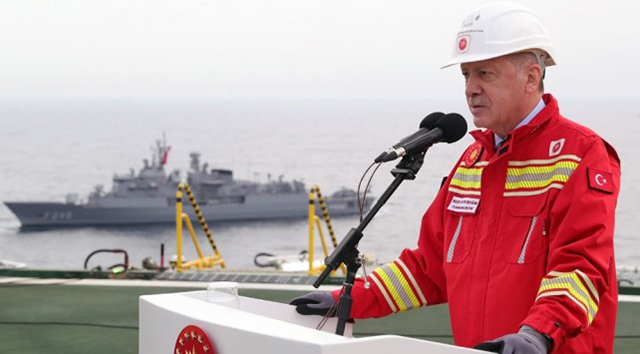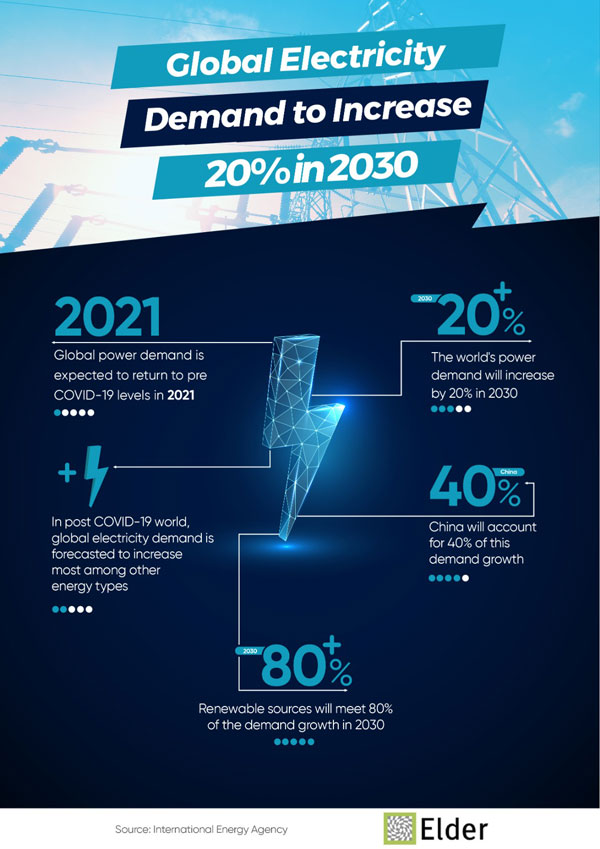
The Turkish president on Saturday announced the discovery of an additional 85 billion cubic meters of natural gas in the Black Sea, following a historic find this summer.
"Total amount of natural gas reserves in the TUNA-1 well in Sakarya Gas Field reached 405 billion cubic meters," Recep Tayyip Erdogan said after his inspections at the drill ship Fatih.
"The reserves we discovered in the Black Sea are the largest hydrocarbon resource of our country till today," he added.
Erdogan's announcement came closely on the heels of the historic natural gas find in August, also in the Black Sea.
Wednesday, speaking to the ruling Justice and Development (AK) Party deputies, Erdogan said: "We will personally witness the efforts on site and announce the amount of the new reserves."
The announcement this August of 320 billion cubic meters in Black Sea reserves by the drill ship Fatih made Turkey "very happy," and now more good news has come, he said.
Following this summer's find, when the Fatih discovered the TUNA-1 well in the Sakarya Gas Field, around 170 kilometers (106 miles) off Turkey's northern coast, Turkish officials had said more reserves might be found soon.
The discovery was the biggest in Turkey's history. Officials have said the gas from the well would be ready for public use in 2023.
Source: Anadolu Agency

Role of NGOs in Turkey Energy Sector took place in the panel that held in International Energy and Environment Fair and Conference.
Serhat Cecen, Chairman of the Board of ELDER, ELDER will contribute as "Supporter" to the "Production, Transmission and Distribution" Conference, which will be held in Istanbul in September 2021 by the world's largest energy community, IEEE.
Serhat Cecen, Chairman of the Board of ELDER who gave information in the panel called Role of NGOs in Turkey Energy Sector which held in the international Energy and Environment Fair and Conference (ICCI), wished that the conference, which was organized digitally for the first time, would be a useful meeting platform for the electricity distribution industry.
Referring to ELDER activities, Cecen said that one of the important missions of ELDER is to improve the innovation environment of the electricity sector in Turkey. Cecen stated that the projects carried out by ELDER enabled the sector to gain a visionary and pioneering perspective and emphasized that it is a platform that tries to bring our country's entrepreneurs to the sector with the aim of developing local and national technologies.
He said that, “In the period of 2014-2020, we made significant contributions to the realization of 194 R&D projects carried out in our sector with the support of EMRA We tried to shape the electricity distribution sector of the future from today by Turkey 2023 Smart Grid Project. I would like to share with you that ELDER contribute to the "Production, Transmission and Distribution" Conference, which will be held in Istanbul in September 2021 by IEEE as a supporter. As IEEE, it will organize this conference for the first time in the European continent.”
Stating that besides ELDER, many NGOs such as EUD, GAZBIR, TUREB, GUNDER and ENVER in different fields of activity of the energy sector operate as umbrella organizations of the sector, Cecen underlined that NGOs strengthen the voice of the sector by providing coordination among the members. Cecen said that, “NGOs increase the synergies of industry stakeholders with their central role. They contribute to the growth, development and efficiency goals of our country with their contribution to the development of the investment environment. They play a role in the design of the future energy sector by supporting R&D projects and start-ups.

Wind and solar power are the cheapest form of new electricity in most of the world today.
That’s the analysis of BloombergNEF, which predicts a tipping point in five years when it will be more expensive to operate an existing coal or natural gas power plant than to build new solar or wind farms.
The findings add to research showing why renewables are spreading in most power markets. Last week, the International Energy Agency said solar is starting to take over from coal as the cheapest form of electricity.
But there is an economic limit to the spread of those sources of clean energy, BNEF’s Chief Economist Seb Henbest said at the research group’s annual conference in London on Monday. There will come a point in every country that saturation point is reached because the technology no longer reduces generation costs compared with running the existing thermal generation fleet.
Those constraints suggest renewables will gain no more than 70% and 80% of the market for electricity generation, depending on local conditions. Even in Europe, which has some of the toughest policies encouraging renewables and discouraging fossil fuels, wind and solar are unlikely to surpass 80% of supply.
That level of penetration “is far off in pretty much every market we look at,” Henbest said in a presentation outlining the first findings of BNEF’s New Energy Outlook, which is due to be published in full later this month. “We’re not going to reach these limits anytime soon and we can of course push past these limits.”
The shift toward renewables is likely to reshape a number of industries, especially the shipping business. A third of the cargo miles hauled by shippers comes from moving fossil fuels around the globe, and 70% of that portion is oil, BNEF estimates. As renewables take market share from oil, gas and coal, the shipping companies that deliver those fuels and keep it fed with machinery and pipelines will also suffer.
“There’s quite possibly a rebasing of shipping demand and rail demand, that might mean less energy consumption and lower emissions,” Henbest said.
Using electricity to heat homes and power cars could save energy and emissions, the report showed. Driving an electric vehicle uses as much as three times less energy than a conventional combustion engine, BNEF said. Switching to heat pumps instead of traditional gas boilers would make warming buildings far more efficient by several multiples, according to the BNEF findings.
It estimates that melting down old steel and reforming it is five times more energy efficient than making the material from scratch.
In power generation, BNEF estimates that coal is also one of the most inefficient ways to make electricity since 65% of energy is lost in the process of burning the fuel. The energy lost in generating electricity from wind is almost zero. The result, BNEF says, is that if renewables take a bigger share of the energy mix, the world will need less energy to generate the same amount of electricity.
“Overall, what this means is that we can get better end use energy efficiency from using electrical processes and technology downstream,” he said. “If we use renewables to generate electricity, we get gains mid-stream as well. Overall this translates into maybe say two to three times less primary energy supply.”
Source: Bloomberg NEF

Forecasts using Cornwall Insight’s Renewables pipeline tracker report shows that a total of 1.3GW of new wind capacity could come online in the UK this winter.
This is a 5% rise in total capacity, which could reach 25.4GW. The below graph highlights the forecast growth of wind capacity to March 2021.
Lucy Dolton, Analyst at Cornwall Insight, said: “New capacity anticipated this winter is almost wholly attributed to the Contracts for Difference scheme.
Additionally, according to Cornwall Insight’s Renewables Pipeline Tracker report, a further 0.4GW could also come online this winter. While there are no guarantees that these sites will commission this winter with limited announcements on confirmed routes to market, it demonstrates additional capacity in the “queue” of wind sites.
“Despite the forecast showing 1.3GW of wind coming online this winter, these deployment levels are some way off the levels needed to meet net-zero. National Grid ESO’s latest FES 2020 report suggests up to 3GW of new wind assets are required annually to meet targets.
“While a growing proportion of wind technologies in the generation mix is necessary for reaching net-zero, it is not without its challenges.
“The lack of inertia arising from a larger proportion of asynchronous technologies, including wind, on the system is one such issue. Lower levels of inertia become problematic due to the increased rate of change of frequency (RoCoF), meaning system frequency can deviate more rapidly. As a result, National Grid ESO requires more actions from generators to balance the system, leading to higher balancing costs and BSUoS charges.
“Another variable affected by the greater wind capacity available on the system is wholesale power prices. A larger share of intermittent generation unsurprisingly brings about increased price volatility, demonstrated by periods of high wind output last winter, resulting in wholesale power prices for day-ahead delivery falling negative for the first time.
“With new capacity coming online this winter and the potential for further impacts on demand due to COVID-19, wind generation could once again create challenges in the market.”
Source: Smart Energy International

Global corporate funding (including venture capital funding, public market, and debt financing) for the Battery Storage, Smart Grid, and Energy Efficiency sectors in Q3 2020 came to $3.2 billion compared to $1.2 billion in Q2, a 165% increase quarter-over-quarter (QoQ).
That’s according to a new report from Mercom Capital Group. Funding was also higher by 777% year-over-year (YoY) compared to the $365 million raised in 20 deals the same quarter last year.
Despite covid-19, total corporate funding for the Battery Storage, Smart Grid and Energy Efficiency sectors in the first 9 months of 2020 was 75% higher with $4.7 billion raised compared to $2.7 billion in the first 9 months of 2019.
Global venture capital (VC) funding (venture capital, private equity, and corporate venture capital) increased in Q3 2020 with $1.1 billion in 22 deals compared to $605 million in 26 deals in Q2 2020, 78% growth QoQ. Funding was higher by 249% YoY compared to $309 million raised in 17 deals in Q3 2019. Global VC funding for Battery Storage, Smart Grid, and Efficiency companies in the first 9 months of 2020 was slightly down with over $1.9 billion compared to $2.1 billion raised in the first 9 months of 2019.
During this time, corporate funding for Battery Storage companies totaled $3.5 billion in 35 deals, 62% higher compared to $2.2 billion in 32 deals in the first 9 months of 2019. Corporate funding in Q3 2020 came to $2.8 billion in 16 deals, compared to $472 million in 10 deals in Q2 2020. VC funding for Battery Storage companies in Q3 2020 was up 78%, with $661 million in seven deals compared to $372 million in eight deals in Q2 2020. The increase in funding was largely due to Northvolt’s $600 million equity raise. In 9M 2020, funding was 25% lower with $1.2 billion in 21 deals compared to $1.6 billion in 25 deals in 9M 2019.
The Top 5 VC funding deals in 9M 2020 were: Northvolt’s raise of $600 million, QuantumScape, which raised $200 million, ProLogium Technology raised $100 million, Demand Power Group secured $71 million, and Highview Power raised $46 million. A total of 28 VC investors participated in Battery Storage funding in Q3 2020.
Announced debt and public market financing for Battery Storage technology companies came to $2.1 billion in nine deals in Q3 2020. In 9M 2020, there was $2.3 billion raised in 14 deals, compared to seven deals bringing in $560 million in 9M 2019. There were three M&A transactions involving Battery Storage companies in Q3 2020 compared to four transactions in Q2 2020. In a YoY comparison, there were four transactions in Q3 2019. In the first nine months of 2020, there were 11 transactions compared to 10 transactions in 9M 2019.
Seven project M&A transactions involving Battery Storage companies were executed in Q3 2020 compared to four in Q2 2020. In a YoY comparison, there were four transactions in Q3 2019. In the first nine months of 2020, there were 15 transactions compared to eight transactions in 9M 2019.
Smart Grid VC funding in Q3 2020 was $368 million in 11 deals compared to $194 million in 14 deals in Q2 2020. In a YoY comparison, funding in Q3 2019 was $39 million in six deals. $643 million was raised in 32 deals in 9M 2020, 231% higher compared to $194 million raised in 28 deals in 9M 2019. VC Funding in Q3 2020 was spread across four Smart Grid technologies: Smart Charging, Distributed Generation and Integration, Smart Grid (SG) Communications, and Data Analytics.
The Top 5 VC funding deals in 9M 2020 were: ChargePoint with $127 million, Star Charge with $125 million, SmartRent with $60 million, Probus Smart Things with $53 million, and Smart Wires with $43 million. Announced debt and public market financing for Smart Grid companies came to $10 million in three deals in 9M 2020 compared to $45 million in two deals in 9M 2019.
There were 12 Smart Grid M&A transactions in Q3 2020 compared to one transaction in Q2 2020. In a YoY comparison, there were five transactions in Q3 2019. In the first nine months of 2020, there were 18 transactions compared to 23 transactions in 9M 2019.
VC funding for Energy Efficiency technology companies increased in Q3 2020, with $48 million raised in four deals compared to $40 million raised in four deals in Q2 2020. In a YoY comparison, funding in Q3 2019 was $61 million in three deals. $95 million was raised in 11 deals in 9M 2020, 65% lower compared to $268 million raised in eight deals in 9M 2019. VC Funding in Q3 2020 was spread across three sub-technologies: Energy Monitors/Dashboards, Data Center, and Efficient Home/Building.
The Top VC funding deals in 9M 2020 were: Palmetto raised $29 million, Juganu raised $18 million, BrainBox AI secured $12 million, Virtual Power Systems raised $12 million, and SmartAC.com raised $10 million.
Source: Environmental Leader

With rising global temperatures and increasingly severe heatwaves, , much of the world’s population is vulnerable to the growing health risks fort he extreme heat.
Cooling is critical for human wellbeing, health and the functioning of society. It enables thermal comfort of societies at high temperatures and is critical for industrial production and for the preservation of food and medicine.
Climate change – alongside increasing affluence, space and comfort needs – means the world is facing an unprecedented growth in cooling demand. This has the potential to drive one of the most substantial increases in energy and greenhouse gas emissions in recent history.
However, despite the central role of cooling in climate change and sustainable development, the risks and benefits of sustainable cooling remain a global blind spot.
In a new “perspective” paper, published in Nature Sustainability, my colleagues and I explore the links between cooling and the United Nations Sustainable Development Goals (SDGs), and put together a framework to help identify solutions to deliver sustainable cooling for all.
According to the International Energy Agency’s (IEA) “Future of Cooling” report, there were 1.6bn air conditioning units in use around the world in 2018. The power needed to keep air conditioners and electric fans running accounts for 20% of global electricity use.
And this is set to increase. The IEA projects that the energy demand from air conditioners will triple by 2050 – equivalent to adding 10 new air conditioners every second for the next 30 years. Powering all these extra units will require an additional electricity generation capacity equal to that of the US, EU and Japan combined.
This increased electricity demand risks locking the world into a feedback loop, where demand for cooling energy drives further greenhouse gas emissions and results in even more global warming – necessitating further cooling.
An alternative approach to the current provision of cooling by traditional air conditioning is that of “sustainable cooling”. By this, we mean the provision of cooling in a manner that maximises its contribution to the SDGs – for example, by minimising health impacts from extreme heat, reducing greenhouse gases, avoiding food loss, and reducing societal inequalities.
Despite the extraordinary projections for its growth, the demand for cooling does not appear in any of the UN’s 2030 Agenda for Sustainable Development, the 17 goals or their 169 targets.
As part of our research, we examined thousands of peer-reviewed papers and grey literature. We identified a series of evidence-based examples of how cooling can contribute to the achievement of the SDGs, demonstrating that cooling is directly linked to all 17 SDGs. While the impact of cooling on energy and sustainable cities might be obvious, cooling is implicated in all of the other goals as well.
With such potential benefits for providing cooling, there is a pressing need to identify sustainable options that do not worsen climate change.
Source: Carbon Brief
Utility Decarbonization Strategies
The power, utilities, and renewables sector is the focus of this transition: Its decarbonization will enable that of other sectors that are electrified or electrifying.
Please click here to read the full report.

